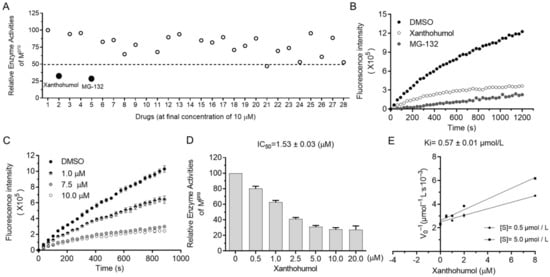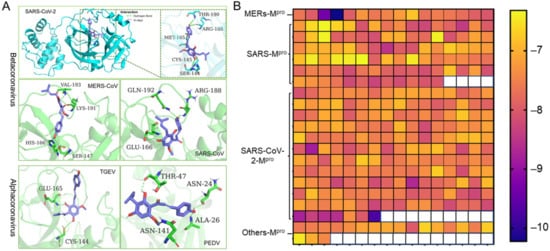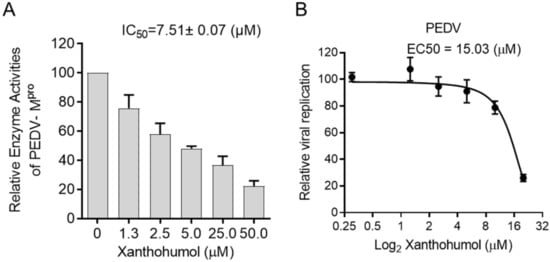Coronaviruses cause diseases in humans and livestock. The SARS-CoV-2 is infecting millions of human beings, with high morbidity and mortality worldwide. The main protease (Mpro) of coronavirus plays a pivotal role in viral replication and transcription, which, in theory, is an attractive drug target for antiviral drug development. It has been extensively discussed whether Xanthohumol is able to help COVID-19 patients. Here, researchers report that Xanthohumol, a small molecule in clinical trials from hops (Humulus lupulus), was a potent pan-inhibitor for various coronaviruses by targeting Mpro, for example, betacoronavirus SARS-CoV-2 (IC50 value of 1.53 μM), and alphacoronavirus PEDV (IC50 value of 7.51 μM). Xanthohumol inhibited Mpro activities in the enzymatical assays, while pretreatment with Xanthohumol restricted the SARS-CoV-2 and PEDV replication in Vero-E6 cells. Therefore, Xanthohumol is a potent pan-inhibitor of coronaviruses and an excellent lead compound for further drug development.
1. Introduction
Coronaviruses (CoVs) infect mammals and birds, leading to severe infectious diseases in rare cases. Most human coronavirus (hCoV) infections cause no, or mild, symptoms, but some become fatal, such as SARS-CoV-2, SARS-CoV, and MERS-CoV [
1,
2]. Animal coronaviruses lead to gross economic losses, with examples including the porcine epidemic diarrhea virus (PEDV), and the transmissible gastroenteritis virus (TGEV) [
3]. To September 2021, SARS-CoV-2 has caused over 200 million infections and 4.58 million deaths worldwide. Vaccines have largely controlled viral infections, but various emerging variants are escaping the neutralization by vaccines. On the other hand, some coronaviruses infecting livestock have been reported to be zoonotic [
4,
5], which may be the origin for the next breakout. It is highly desirable to screen pan-inhibitors for emerging coronaviruses.
Coronaviruses are large positive-strand RNA viruses, with a unique life cycle, belonging to the Coronaviridae family [
6]. After entry, viruses immediately translate two polyproteins, pp1a (~450 kDa) and pp1ab (~750 kDa), using their genomic RNA, and generate 12–16 individual nonstructural proteins (NSPs) by the cleavages of the main protease (M
pro or 3CLpro) and papain-like protease (PLpro). NSPs assemble into viral replication machinery, taking part in various critical processes, such as genome duplication, protein translation, and immune evasion [
6]. To be noted, these viral proteins are highly conserved in the Coronaviridae family, which means chemicals targeting these proteins might inhibit multiple coronaviruses. Thus, people initially expected that the RdRp (RNA-dependent RNA polymerase) inhibitor, Remdesivir (GS-5734), could cure COVID-19 patients because its parent chemical, GS-441524, displayed antiviral activities against other CoVs [
7,
8]. Unfortunately, the unsuccessful clinical trials of Remdesivir for COVID-19 remind us that screening novel antiviral agents remains attractive, especially for pan-inhibitors against coronaviruses [
9].
M
pro is a viral-encoding cysteine protease [
10]. Protease inhibitors are attractive candidates for antiviral drug development. Many protease inhibitors have been marketed as antiviral agents (i.e., Boceprevir for HCV, Darunavir for HIV). Because coronaviral M
pro is distinct from all human proteases [
10], and critical in the viral life cycle, compounds that suppress M
pro activities may be pan-inhibitors of coronaviruses without side effects. The first generation of M
pro is the covalent inhibitor, N3, which mimics the native substrate peptides with additional Michael acceptors as warheads [
11]. More and more peptidic inhibitors/peptidomimetics have been developed with amazing activities and low toxicities, for example, GC-376, 11a, and 11b [
12,
13]. Moreover, M
pro inhibitors have also been found via high-throughput screening approaches. Ebselen, PX-12, and carmofur may covalently interact with the C145 residue of M
pro, which is critical to its catalytical activities [
14]. Pfizer has announced the launch of a phase I clinical trial with PF-07321332 [
15]. Until now, it is the first M
pro inhibitor in a clinical trial, and we are expecting the coming clinical results.
Plants are excellent resources for protease inhibitor discovery. Shikonin, a natural product from herbs, is a potential M
pro inhibitor against SARS-CoV-2 [
14]. Phenolic compounds (PCs) from plants and their derivatives present antiviral activities against HSV-1, HIV, HCV, and others [
16]. Phenolic compounds (PCs) are generally found in fruits, vegetables, herbs, flowers, and seeds, including phenolic acids and flavonoids (flavonols, catechins, flavones, chalcones, etc.). Xanthohumol is a prenylated chalcone from the hop plant (
Humulus lupulus) that contributes to the bitterness in beer. It has been highly analyzed by researchers as an antiviral agent or antioxidant [
17]. It has been reported to inhibit cervical cancer, colorectal cancer, and prostate cancer [
18,
19,
20,
21]. Our previous works found that Xanthohumol regulated the Th1/Th2 balance in a tumor model [
22]. Xanthohumol inhibits HSV-1 with an IC
50 value of 2.7 μg/mL, HIV with an IC
50 value of ≈20.74 μg/mL, and CMV with an IC
50 value of 2.5 μg/mL [
23,
24]. Because of its potent utilization of its antioxidant and anti-inflammatory properties, Xanthohumol has been approved in clinical studies for the safety and subjective tolerability in healthy adults (NCT03735420) [
25]. After the breakout of COVID-19, many researchers keep discussing the potent roles of Xanthohumol against SARS-CoV-2. In this study, we found that Xanthohumol inhibited M
pro, and that it was a potent pan-inhibitor against various coronaviruses. Xanthohumol restricted SARS-CoV-2 and PEDV in vitro. This suggests the potential of Xanthohumol as a coronavirus M
pro inhibitor.
2. Coronaviral Mpro Is Highly Conserved
M
pro contains three conserved domains: I, II, and III. Domain I and II are closely interacted to form a cleft, forming a catalytic core and substrate binding sites. His-41 in Domain I, and Cys-145 in Domain II, are catalytic dyads [
10,
26]. As shown in
Figure 1A, His-41, Cys-145, and their neighbor residues were highly conserved in alpha-coronaviruses (i.e., PEDV and TGEV) and beta-coronaviruses (i.e., SARS-CoV and SARS-CoV-2). Moreover, the three-dimensional (3D) structures were similar for various M
pro (
Figure 1B), and the amino acid sequences of Domain I and II were consistent in pathogenic coronaviruses (i.e., SARS-CoV-2, SARS-CoV, PEDV, and MERS-CoV) (
Figure S1). This suggests that M
pro is a promising drug target for pan-inhibitor screening against coronaviruses. Interestingly, the cysteine protease inhibitor, GC376, is a potent M
pro inhibitor that shows antiviral activities against SARS-CoV-2, SARS-CoV, and feline coronavirus (FCoV) [
27,
28]. A recent study developed a pan-inhibitor of M
pro restricting multiple coronaviruses in vitro [
29]. It suggests that M
pro inhibitors might be pan-inhibitors against coronaviruses.
Figure 1. The conserved amino acid sequences and 3D structures of the Mpro catalytic domains for different coronaviruses. (A) Alignment of neighbor residues on both flanks of the pivotal residue His41, Cys145. (B) The three-dimensional (3D) structures of Mpro are highly conserved.
3. SARS-CoV-2 Mpro Inhibitor Screening
To screen M
pro inhibitors, recombinant GST-tagged M
pro was generated from the E. coli BL21/DE3 strain (CodonPlus, Agilent Technologies Inc., Santa Clara, CA, USA;) using pGEX4 vectors. Since any additional amino acid residues in the N-terminus of M
pro could reduce its activity [
11,
27], tags were removed by Factor Xa (P8010L, New England Biolab, Ipswich, MA, USA) to generate native M
pro proteins (
Supplementary Figure S2A). The Michaelis constant (Km) was measured to verify the hydrolase reaction. The Km value was 1.10 ± 0.22 μM (
Supplementary Figure S2C), referring to a high affinity between the substrates and the enzyme.
The orchestrated protease system of cells is essential to many biological processes (i.e., misfolded protein degradation, inflammation, antimicrobe invasion, and digestion) that require the low toxicity of protease inhibitors as drug candidates. Since protease inhibitors are abundant in animals and plants, we decided to screen M
pro inhibitors from natural products, especially focusing on natural products from foods, food additives, and herbs, which were safe and easily accessible in theory. As shown in
Supplementary Figure S2D, more than a hundred natural products were randomly picked from the compound bank and briefly screened at the final concentration of 50 μM. Hits were further tested in the presence of 10 μM compounds, and candidates with an inhibition rate of more than 50% were considered as active. Surprisingly, Xanthohumol and MG132 almost abolished the enzyme activities of M
pro at the final concentration of 10 μM (
Figure 2A,B). MG132 is a well-established broad-spectrum proteasome inhibitor, used as a spy compound here.
Figure 2. Xanthohumol inhibited hydrolase activities of SARS-CoV-2 Mpro in a dose-dependent manner. (A) Relative enzyme activities of SARS-CoV-2 Mpro in the presence of 10 μM compounds. (B) The kinetic curves in the presence of Xanthohumol, MG132, and the solvent, DMSO. Xanthohumol and MG132 were added to the final concentration of 20 μM. (C) Xanthohumol inhibited Mpro dose-dependently. (D) The IC50 value of Xanthohumol. (E) The Ki value of Xanthohumol on SARS-CoV-2 Mpro. Data are shown as means ± standard error of mean (SEM) from three independent experiments.
It was found that Xanthohumol reduced Mpro hydrolase activities at low concentrations in vitro in a dose-dependent manner (Figure 2C,D). The half inhibition concentration of Xanthohumol on SARS-CoV-2 Mpro was 1.53 ± 0.03 μM (Figure 2D). As discussed in our early publications, the IC50 value of enzyme inhibitors is closely related to the enzymatical assay. To further analyze the inhibition efficiency of Xanthohumol on SARS-CoV-2 Mpro, the Ki (the inhibition constant for the inhibitor) value was also measured, which was 0.57 ± 0.01 μM (Figure 2E). It indicated that Xanthohumol reduced SARS-CoV-2 Mpro enzymatic activities efficiently in vitro.
4. Xanthohumol Potentially Inhibits Various Coronaviral Mpro
Coronaviruses are members of the Coronaviridae family. They are further subdivided into four genera: alpha-, beta-, gamma-, and delta- coronaviruses. The alpha- and beta- coronaviruses infect only mammals [
1]. Noting that the 3D structure and the catalytic dyads of M
pro are conserved in alpha- and beta- coronaviruses, we employed molecular docking to predict the potent inhibition activities of Xanthohumol against various coronaviruses. A high-quality crystal structure of SARS-CoV-2 M
pro has been reported earlier [
10], and the crystal structures of SARS-CoV, MERS-CoV, PEDV, and TGEV M
pro have been explored as well [
30,
31,
32,
33]. As shown in
Figure 3A, Xanthohumol could be docked into the active pocket of a series of coronaviruses, M
pro, and form hydrogen bonds and other molecular interactions. Most docking scores are between −6 to −8, which indicate that Xanthohumol presents excellent affinities with various M
pro structures (
Figure 3B and
Supplementary Data). To be noted, a hydrogen bond was found between Xanthohumol and the Cys-145 of SARS-CoV-2 M
pro that was essential to M
pro catalytical activities, explaining that Xanthohumol inhibited SARS-CoV-2 efficiently. It indicated that Xanthohumol is a potent drug candidate for further drug development.
Figure 3. Xanthohumol is a potent pan-inhibitor of coronaviral M
pro. (
A) The interaction pattern between Xanthohumol and indicated M
pro. The M
pro was shown in cyan and green. The Xanthohumol was presented in purple. (
B) The affinity diagrams between Xanthohumol and different M
pro. M
pro structures were downloaded from PDB, and the PDB ID and detailed docking scores are shown in
Supplementary Data.
5. Xanthohumol Restricts SARS-CoV-2 and PEDV Replication in the Cell-Based Assay
Many chemicals presented significant inhibition efficiency in the enzymatic assay but failed in cell models because of their poor permeability, improper cellular metabolism, and other issues. We were wondering if Xanthohumol were able to hamper SARS-CoV-2 replication in cells. Calpeptin, a well-established cell-permeable cysteine protease inhibitor, was used as the positive control. Calpeptin significantly restricted SARS-CoV-2 infection (IC
50 = 0.38 ± 0.01 μM), indicating that the infection model could properly reveal the inhibition activity of candidate compounds (
Supplementary Figure S3A). To be noted, Xanthohumol dose-dependently inhibited SARS-CoV-2 in cells (
Figure 4A,B), while it did not slow cell growth, and only negligibly reduced cellular viability at the high concentration (
Figure 4C). In a plague assay, the IC
50 value of Xanthohumol on SARS-CoV-2 was 5.93 ± 0.45 μM (
Figure 4A). M
pro cleaves viral polyprotein to assemble viral replication machinery, which is critical for viral RNA duplication. This suggests that M
pro inhibitors could directly inhibit viral RNA replication by hampering the replication machinery assembly. To monitor whether Xanthohumol could inhibit SARS-CoV-2 RNA duplication by targeting its M
pro, viral RNA loads of infected cells were also measured by qRT-PCR. This indicated that Xanthohumol could eliminate the viral genome effectively, which is highly consistent with the results from the plague assays mentioned above (
Figure 4B). Moreover, the CC50 (the half cytotoxic concentration) value of Xanthohumol in Vero-E6 cells was 57.04 ± 2.11 μM, and the selection index was more than 9.5. This suggests that Xanthohumol is an outstanding lead compound for further developments.
Figure 4. Xanthohumol inhibited SARS-CoV-2 replication in Vero-E6 cells. (A) Xanthohumol-inhibited SARS-CoV-2. Vero-E6 cells were pretreated with compounds at indicated concentrations for 1 h, and then infected with recombinant SARS-CoV-2 mNeonGreen virus (MOI = 0.5) for 24 h. The green fluorescence was scanned as described. The EC50 values of Xanthohumol were calculated and are shown. (B) Xanthohumol reduced viral RNA loads. SARS-CoV-2 N mRNA was measured with qRT-PCR and normalized to GAPDH. (C) Cytotoxicities of Xanthohumol. Data are shown as means ± SEM from three independent experiments.
Considering the structural similarity between PEDV and SARS-CoV-2 Mpro, we were wondering if Xanthohumol would inhibit PEDV Mpro enzymatic activity and then restrict PEDV replication. The enzymatic assay was performed as SARS-CoV-2, in which the PEDV Mpro was used instead of SARS-CoV-2 Mpro. It indicated that Xanthohumol inhibited PEDV Mpro efficiently with an IC50 value of 7.51 ± 0.07 μM (Figure 5A). Moreover, Xanthohumol dose-dependently inhibited PEDV in Vero-E6 cells (Figure 5B).
Figure 5. Xanthohumol inhibited PEDV Mpro and PEDV in vitro. (A) Xanthohumol inhibited PEDV Mpro. (B) Xanthohumol inhibited PEDV replication in vitro. Vero-E6 cells were pretreated with the indicated concentration of Xanthohumol for 1 h and infected with PEDV (MOI = 1). Data are shown as means ± SEM from three independent experiments.
This entry is adapted from the peer-reviewed paper 10.3390/ijms222212134





